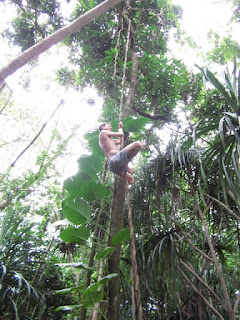Food
Our host shot two pigs this week, the first he's ever killed, and the first Jasmine and I have ever butchered! For the first boar, it took the three of us about 6 hours to set up a butchering station, hoist him up, gut him, skin him, make initial rough cuts, and pack the meat into a cooler and a bucket with ice. The next day the three of us spent about 4 more hours rendering the fat (see picture below left), cutting the meat off the bones into meal-sized chunks, and packing it into a neighbor's freezer. We made stew the first night from the backbone, and fried some meat cuts the next day. Jasmine and I had felt some concern that we might not like wild pig; some people describe it as gamey or tough or otherwise inferior to domestic meat. But after tasting it, I deem it the best meat I've ever eaten! Our host and I worked on the second pig mostly by ourselves, with Jasmine providing some support. It took the two of us 5 hours to process a larger pig, including the head (which we'd discarded from the first pig), and we did a much better job of retaining the fat with the meat instead of losing it by leaving it attached to the hide.For the past few weeks, we've obtained all our necessary foods by foraging and work trade at the farm down the street, except for the crucial staples of cooking oil and meat. I feel really excited that we've closed that last gap and achieved semi self sufficiency in food within one month of arriving; the bounty of this land amazes me! (Reality checks: 1) much of the bounty comes from the work of folks in the past planting the perennial trees from which we forage now. 2) We're living at a very low elevation with relatively abundant sun and rainfall, perhaps an ideal microclimate for food trees. 3) We have not yet learned to use a gun, let alone something we can make ourselves such as bow & arrow; we're relying on our host right now to kill the pigs. 4) I don't know how many pigs live in the area and how often we could continue to shoot them without depleting their numbers or scaring them away.)
We had our first taste since moving here of that other Hawaiian classic - ulu, or breadfruit, a staple carb that grows on trees in convenient 1+ pound balls. Ours hadn't reached peak ripeness, so hadn't developed the sweetness of a fully ripe, soft breadfruit, but Jasmine and I both enjoyed it a lot as a blander starch. We also tried two more fruits from different trees of the related jackfruit. Though jackfruit requires a fair amount of work to process, the flavor and multiple yields of fruit and starchy seed has begun to convince me that we should grow one or two. Other new tastings: naranjilla (they remind us of kiwis, with a nice tart taste and similar texture), tree tomato (a lot like a tomato but with a thick, fruit fly proof skin), abiu (sweet & custardy but not much flavor), and yet another breadfruit & jackfruit relative: chempedak (delicious).
Our experience so far confirms my expectation that we can easily procure all the food we need for our tribe by growing perennial plants and hunting pigs. We hardly even need chickens and goats for their food products, though they have so many other uses in the systems (especially for weed and pest control, nutrient cycling, and goat walking) that it doesn't make sense to build permaculture systems without them. Once we develop our own food systems, we may quickly find ourselves with excess to share with the larger community!
After days of talking about it, Jasmine and I finally split a tub of Alden's Cookies & Cream ice cream (on sale at the local natural food store) and ate it for dinner. After eschewing sugar and grains and processed foods for weeks in favor of amazing fresh fruits and greens and taro and local beef, we both decided the ice cream wasn't all that great. I can't say that's the last time I'll succumb to processed sugar in a package, but the experience definitely decreased the temptation.
Learning
I've still been reading the Traditional Trees of Pacific Islands book, and read Sarah Vowell's Unfamiliar Fishes, an easy to read and seemingly balanced history exploring the impact of missionaries on Hawaii, the overthrow of the monarchy, and how it all tied in to the expansion of US imperialism. Jasmine and I both worked some more on our lists of plant species.We attended an event at La'akea, a local permaculture community, where we learned new information about two fairly recent, rapidly spreading problems for humans in Hawaii: little fire ants, and rat lungworm disease (a potentially dehibilitating and/or lethal nematode when it accidentally winds up in human brains instead of its usual rat and slug/snail hosts.)
Networking
We met a few new people at the La'akea event, and Jasmine chatted a little bit with a pig hunter visiting at Clive's farm. The hunter loves talking about pigs, and we love learning about pigs, so I'm hoping to get a chance to talk with him too!









